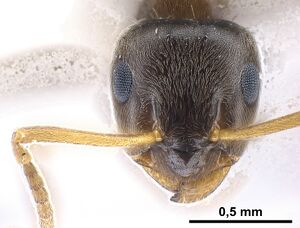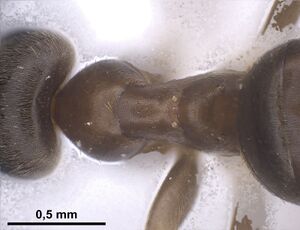Lasius precursor
| Lasius precursor | |
|---|---|

| |
| Scientific classification | |
| Kingdom: | Animalia |
| Phylum: | Arthropoda |
| Class: | Insecta |
| Order: | Hymenoptera |
| Family: | Formicidae |
| Subfamily: | Formicinae |
| Tribe: | Lasiini |
| Genus: | Lasius |
| Section: | niger clade |
| Species group: | brunneus |
| Species complex: | turcicus |
| Species: | L. precursor |
| Binomial name | |
| Lasius precursor Seifert, 2020 | |
A lower elevation sister species of Lasius turcicus.
Identification
Seifert (2020) - Palaearctic Lasius s. str. species belonging to the Lasius turcicus species complex. Morphologically differs from its sister species Lasius turcicus by its smaller absolute size, shorter scape, larger postocular distance and smaller torulo-clypeal distance. Differences in their natural history are detailed below in the biology section.
Borowiec and Salata (2022), studying the ants of Greece, grouped three species (Lasius turcicus, Lasius neglectus and Lasius precursor) within the L. turcicus species-group under a single description, showing the difficulty in separating these species according to their morphology.
Keys including this Species
- Key to Lasius species of the subgenus Lasius of Greece
- Key to Palaearctic Lasius s. str.
- Key to Palaearctic Lasius subgenus Lasius s. st.
Distribution
Seifert (2020) - In Turkey, known from Anatolia between 26°E and 31°E and from the Greek island of Kos (36.85°N, 27.08°E), close to coast of West Anatolia. The altitudinal distribution of 51 samples ranges from 5 to 1,116 m with the median at 237 m and 86% of all findings below 400 m. This differs significantly from the situation in 77 sympatric L. turcicus samples with the median at 1,007 m, 74% of all samples above 400 m and a range from 1 to 1,170 m (one-tailed Mann-Whitney U-test p<0.0005).
Distribution based on Regional Taxon Lists
Palaearctic Region: Türkiye (type locality).
Distribution based on AntMaps
Distribution based on AntWeb specimens
Check data from AntWeb
Countries Occupied
| Number of countries occupied by this species based on AntWiki Regional Taxon Lists. In general, fewer countries occupied indicates a narrower range, while more countries indicates a more widespread species. |

|
Habitat
Borowiec and Salata (2022) - According to Seifert (2020 a) Lasius precursor was collected in rural grassland. The altitudinal distribution of 51 samples ranges from 5 to 1116 m with the median at 237 m and 86% of all findings below 400 m.
Biology
Seifert (2020), summarizing Cremer et al. (2008): they found the following differences in the biologies of L. precursor and Lasius turcicus: Gynes of L. precursor show a trend to mate within colonies and reduced dispersal rates compared to L. turcicus which is in line with the smaller absolute size and shorter wings of the former. Gynes of L. turcicus are larger and longer-winged, never showed intranidal mating in 106 nest box trials, and are better dispersers. Combining L. turcicus gynes with males of L. precursor resulted in 38% matings in 29 tests. In contrast, L. turcicus males never mated L. precursor gynes in 51 tests, suggesting that the males of L. turcicus need to fly before being able to copulate. This suggests that part of the L. precursor populations are propagated by intra-nest mating and colony budding, but without being invasive. Intraspecific aggression among workers of different nests was high in L. turcicus, lower but still significant in L. precursor and absent in Lasius neglectus. Relatedness was moderately high (0.392 ± 0.070) in nests of L. precursor, whereas it reached in L. turcicus levels consistent with territorial colonies headed mostly by a single queen (0.561 ± 0.034). L. precursor shows an intermediate social structure between the supercolonial invasive L. neglectus and the highly structured L. turcicus populations: in L. precursor, several ‘small-scale supercolonies’ coexist in most populations, but without coming close to the sizes of the extensive L. neglectus supercolonies. Long-chain hydrocarbons were relatively frequent in L. precursor and rare in L. turcicus. The less volatile longchain hydrocarbons have been hypothesized to be less informative as recognition cues which is consistent with the lower aggression levels in L. precursor compared to L. turcicus.
Castes
Worker
Images from AntWeb
   
| |
| Holotype of Lasius precursor. Worker. Specimen code antweb1041450. Photographer Roland Schultz, uploaded by California Academy of Sciences. | Owned by SMNG, Görlitz, Germany. |
Nomenclature
The following information is derived from Barry Bolton's Online Catalogue of the Ants of the World.
- precursor. Lasius precursor Seifert, 2020: 51, figs. 15-16 (w.aq.) TURKEY.
Unless otherwise noted the text for the remainder of this section is reported from the publication that includes the original description.
Based on investigation of cuticular hydrocarbon patterns, nuDNA (microsatellite data), Cremer et al. (2008) unambiguously supported the separate species identity of Lasius neglectus from Lasius turcicus. This finding is in line with the results of NC-clustering from this study. Yet, Cremer et al. also reported that Lasius turcicus in the conception of Seifert (2000) can be divided into two entities which they called the highland form (= L. turcicus) and the lowland form (= L. precursor introduced here). They found clear differences between the two entities in cuticular hydrocarbons and microsatellite data.
Description
Worker
Body size small (CS 769 µm). Number of mandibular dents low (MaDe900 7.6). Clypeal pubescence dilute (sqPDCL900 5.13). Pronotal setae rather short (PnHL/ CS900 0.127), very little longer than gular setae (GuHL/ CS900 0.125). Petiole scale in profile view rather thin with an acute dorsal tip. Pubescence hairs on frons rather long (PLF900 34.5 µm). Dorsum of scape and hind tibiae without or few, occasional setae. It differs from Lasius neglectus by shorter scape (SL/CS900 0.946), larger postocular distance (PoOc/CL900 0.238), smaller torulo-clypeal distance (dClAn/CS900 3.61%) and fewer setae on posterior margin of head (nOcc900 5.8). The most significant differences to Lasius turcicus are smaller absolute size, shorter scape, larger postocular distance and smaller torulo-clypeal distance. Coloration: Head and gaster dark brown, mesosoma often suggested lighter; mandibles, antennae, lateral part of clypeus, tibiae and tarsae light yellowish-brown.
See table 2 in Seifert 2020 for additional morphometrics. The abbreviated names of various quantitative data shown above are defined here: Seifert 2020 Lasius characters.
Type Material
Holotype worker plus 4 paratype workers and 3 alate gynes labelled ”TUR:39.795° N,26.681°E, Üzümlü-1.1 km N, 167 m, rural grassland, leg. Cremer et al. 2004.06.08 -712“; 5 paratype workers plus 2 males labelled ”TUR:39.795° N,26.682°E, Üzümlü-1.1 km N, 160 m, rural grassland, leg. Cremer et al. 2004.06.08-710“; depository Staatliches Museum für Naturkunde Görlitz.
Etymology
From an evolutionary perspective, colony demography and behavior this species can be considered as a precursor of the situation in Lasius neglectus. Lasius precursor probably represents a rather recent split-off from Lasius turcicus and may probably serve as a genetic model for transition from monogyny in L. turcicus to true supercoloniality.
References
- Borowiec, L., Wieczorek, K., Salata, S. 2021. Review of ants (Hymenoptera: Formicidae) of the Dodecanese Archipelago, Greece. Annals of the Upper Silesian Museum in Bytom Entomology 30: 1-33 (doi:10.5281/ZENODO.5571270).
- Kiran, K., Karaman, C. 2020. Additions to the ant fauna of Turkey (Hymenoptera, Formicidae). Zoosystema 42(18), 285-329 (doi:10.5252/zoosystema2020v42a18).
- Seifert, B. 2020. A taxonomic revision of the Palaearctic members of the subgenus Lasius s.str. (Hymenoptera, Formicidae). Soil Organisms 92(1): 15-86 (doi:10.25674/so92iss1pp15).

